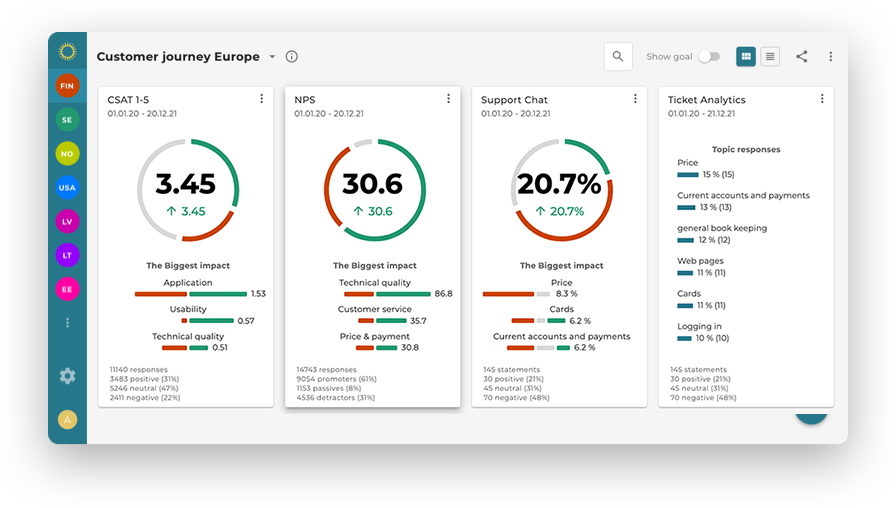What is Voice of the Customer: Surveys, Feedback and Research Practices

Last updated on July 7, 2023
With all relationships, taking the time to listen is crucial to its success. Nowhere is this more true than with customer relationships. Without listening to the voice of your customer, you’ll be like a ship without a rudder or a compass…lost and drifting without direction.
But listening isn’t always that easy. Customers don’t always take the time to express their feelings. Analyzing the feedback that you do get can be overwhelming, especially when it’s coming from so many different sources. This is where a Voice of the Customer approach can help by organizing and prioritizing customer insights into a usable format.
In This Article:
What is the Voice of the Customer (VoC)?
Voice of the Customer (VoC) is a research technique aimed at gaining a thorough understanding of the customers’ perceptions, experiences, and emotions toward a business. The term “Voice” is used in a metaphorical sense, as customers may not express their thoughts and feelings verbally or through traditional feedback channels. VoC delves beyond the surface level of customer feedback to uncover their underlying desires, requirements, and expectations. By utilizing VoC, businesses can gain valuable insights into how their customers truly feel about their products, services, and overall brand image.
Implementing a VoC program will help you understand your customers better and know where to focus your efforts on improving the customer experience. By leveraging VoC, businesses are able to gather critical insights into their customers’ needs, expectations, and pain points. Rather than simply addressing the most pressing issues or complaints, VoC enables businesses to make data-driven, customer-centric decisions that result in meaningful and sustainable improvements in the customer experience.
With a well-designed VoC program in place, businesses can gain a competitive edge by focusing their efforts on the areas that matter most to their customers, ultimately driving customer satisfaction, loyalty, and growth.
Examples of VoC
There are so many different ways customers can share information about what they want. If you’re only collecting VoC data through a feedback form, you’re missing out on valuable insight. Here are just a few examples of data that could be included in VoC.

- A customer mentions during a service call that they’ve had trouble finding the new permissions settings in their account dashboard.
- While canceling their account, a customer indicates that “customer service” was the main reason they are leaving.
- On Twitter, a customer tweets to let their followers know how much they love using your service.
- During an NPS survey, a customer replies with a 7 and comments that they’d love to see the reporting section expanded.
- A customer clicks repeatedly on spot in the screen in quick succession before scrolling down the page and exiting.
In short, anywhere your customer talks about their experience with your business, or interacts with you is an example of VoC.
Why you should care about the Voice of the Customer?
It’s unlikely we need to convince you of the power of listening to your customer. It’s been consistently proven that customer-centric companies out-perform their competitors in revenue, customer loyalty, and growth:
- 72% of customers will spread the word about a positive experience to at least six people when they receive good customer service.
- Organizations that analyze and act on their customer behavioral data outperform the market by 85% in sales growth, according to a 2021 study by Microsoft.
- 45.9% of business professionals says this is their top priority for the next 5 years
Caring about the Voice of the Customer puts your company in a better position to make customer-centric decisions and provide a great customer experience. When you capture VoC data, you can:
- Evaluate new product and service offerings, and prioritize based on customer expectations.
- Customize your brand to better align with your customers’ needs.
- Proactively adjust customer service strategies to avoid issues or red flags.
- Retain more customers, and improve your relationships with customers.
How do you collect VoC data?
There are as many ways to collect VoC data as there are types of data. From qualitative to quantitative information, actively soliciting feedback to passively analyzing user behavior, text analysis to interviews, VoC data collection can run the gamut. Here are 6 ways you can collect VoC data:
Customer Surveys: often what most people think of first when it comes time to collect feedback. Customer surveys include customer satisfaction surveys, NPS, and long-form questionnaires.
Customer Conversations: whether you’re talking to customers on the phone, over email, or through chat, the transcripts hold valuable information. Analyzing this text and voice data can provide insight into what your customers are talking about, as well as the sentiment.
Focus Groups: when you want to get deep into conversations with your customers, focus groups are an excellent way to ask deeper questions. You also have more control over which customers are invited to respond, so you can be very specific.
Social Media: even if you aren’t listening, customers will be talking about you on social media and other websites. Reviews, tweets, and forum posts can all help you understand what your customers are talking about (when they don’t think you’re listening).
Website Behavior: it’s not just about what your customers are saying, but also how they act. How users interact with your product, app or website contains lots of valuable information about what they expect and where their journey falls flat. Tracking user data and behavior can help you make sense of what users are actually doing on your platform.
Feedback Forms: make it as easy as possible for customers to provide feedback by including forms in common spaces. For example, pop-out feedback forms on your website can collect feedback from a wide range of customers, with minimal effort. Compared to the lengthy process of finding a phone number and feedback forms are a low-barrier way for customers to tell you what they really think.
How to make customer-centric decisions based on VoC
Now that you have your data, how can you put it into a usable format so you can make decisions with it? That’s often the biggest challenge when it comes to creating effective VoC programs. If you’re collecting VoC input through different channels (and you should be!) it can feel overwhelming to sort through the data.
Without the right tools, you won’t have a full overview of your VoC sources and no one will be able to make use of this valuable data, which can lead to blindly making decisions based on gut instinct.
Survey responses come in through your survey provider, reviews are available only on third-party sites, and customer conversations are all stored in your contact center. This makes it impossible to understand what’s really happening. Are customers talking or complaining about the same stuff on all the different channels? or is it different? and if it is, what do they talk about?
Once you’ve managed to make sense of this data, the problem happens again – each of your functional teams needs access to the data. Product, support, and marketing teams all receive value from VoC insights, but if they are trapped in a silo, you lose the benefits.
Creating a full overview of the Voice of Customer
The solution to making VoC data actionable is to have a centralized view of the data to analyze, with insights easily shareable across the organization so that everyone can make informed decisions.
Most companies today use metrics like NPS, CSAT, and online ratings to gauge customer satisfaction, but they struggle to understand what drives these numbers.
Sifting through large amounts of feedback from various sources and finding meaningful insights can be overwhelming. That’s where Lumoa comes in. Lumoa automates the analysis of customer interactions and highlights the key drivers of customer satisfaction, enabling companies to see a noticeable improvement in their customer metrics.

Lumoa offers a centralized platform for all customer feedback, making it easy to view an overview of customer opinions and compare feedback across different channels. With the help of voice and text analytics, the data analysis process is made even easier.
Moreover, Lumoa helps distribute customer insights throughout the organization, eliminating the need for each department to conduct its own surveys.
By bringing the entire team on board with a comprehensive Voice of the Customer (VoC) overview, every team can make informed decisions based on customer feedback.
Want to discover the full potential of your Voice of the Customer (VoC) data with Lumoa? Sign up for a FREE TRIAL today and experience the benefits for yourself!
